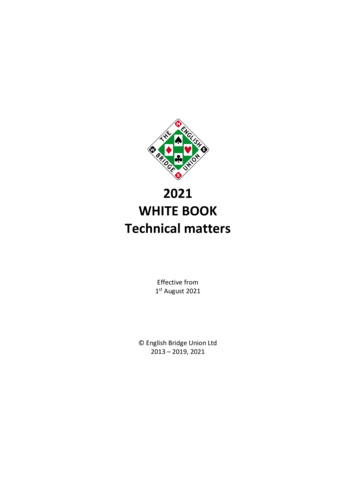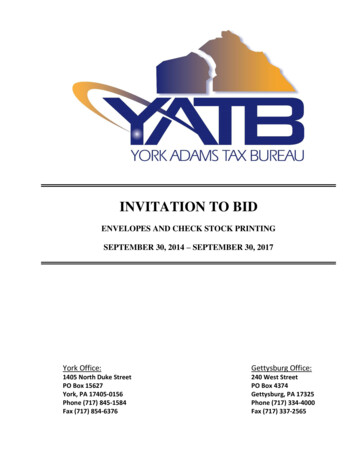
Transcription
The E ectiveness of White-Collar Crime Enforcement:Evidence from the War on TerrorTrung Nguyen Stanford UniversityNovember 7, 2017AbstractThis paper studies the deterrent e ect of criminal enforcement on white-collar criminal activities.Using the 9/11 terrorist attacks as a shock to the FBI’s allocation of investigative resources and priorities,and variations in the Muslim population in the United States as a measure of geographic variations inthe shock, I examine two questions: (1) Does the bureau’s shift to counter-terrorism investigations after9/11 lead to a reduction in the enforcement of laws targeting white-collar crime? (2) Does white-collarcrime increase as a result of less oversight? Using a di erence-in-di erences estimation approach, I findthat there is a significantly greater reduction in white-collar criminal cases referred by FBI field officesthat shift their investigative focus away from white-collar crime to counter-terrorism. I also find thatareas overseen by FBI field offices that shift their attention from white-collar crime to counter-terrorismexperience a significantly greater increase in wire fraud, illegal insider trading activities, and fraud withinfinancial institutions. I am grateful to my advisers: David Larcker (dissertation committee chair), Anne Beyer, Lauren Cohen, Maureen McNichols and Joseph Piotroski. I would also like to thank seminar participants at Stanford University for helpful suggestions. Ithank Daniel E. Ho, Rebecca Lester, Quoc Nguyen, and Eugene Soltes. I am grateful for the Transactional Records AccessClearinghouse (TRAC) and Susan Long for data. I have benefited from conversations with former SEC lawyers, retired FBIagents, US assistant attorneys, and legal academics. I thank my fellow Ph.D. students for support. All errors are my own. Ican be reached at trungn@stanford.edu.
1IntroductionWhite-collar crime, which consists primarily of financially motivated illegal actions characterized by deceitand fraud, ranging from wire fraud and Ponzi schemes to illegal insider trading and accounting fraud, canhave devastating consequences for investors and the financial market. After high-profile financial failures andcorporate fraud scandals, such as the Enron accounting scandal, the Mado Ponzi scheme, and the mortgagefraud epidemic that precipitated the recent financial crisis, many observers call for stricter regulation andincreased enforcement of laws against white-collar crime. However, whether white-collar crime can be e ectively deterred by plausible variations in enforcement e orts and, if so, at what cost and with what deterrente ects remain largely unresolved questions.On the one hand, researchers have found evidence suggesting that white-collar criminals are responsive tothe cost of committing crime and can be deterred by regulators’ enforcement actions (Kedia and Rajgopal,2011). The idea that criminals respond to changes in the cost of committing crime is formalized in Becker’s(1974) model, which depicts criminals as rational agents who maximize their expected utilities and weighthe benefits and costs of committing a crime. Edward Swanson, a white-collar criminal defense attorney atSwanson & McNamara LLP, believes that the deterrent e ect of criminal prosecution is high for white-collarcrime because “white-collar crime prosecutions heavily a ect behavior in the business community, and theknowledge that you might be prosecuted is an e ective deterrent.”On the other hand, given that the punishments for and negative consequences of financial misconduct arequite severe, it remains a puzzle why financial fraud still persists. Psychologists and criminologists considercriminals to have at most limited rationality, finding it difficult to assign monetary value to the potential costof committing a crime (Carroll, 1978). Behavioral economists believe that bounded rationality and boundedwillpower might explain criminals’ departure from Becker’s model (Jolls, Sunstein, and Thaler, 1998). Afundamental attribution error and moral pessimism can lead criminals to underestimate the probability ofbeing caught. Legal scholars also find that white-collar defendants do not seem to hear the deterrencemessage that punishments by the legal system are intended to communicate to them (Henning, 2015).In their review of the financial misconduct literature, Amiram, Bozanic, Cox, Dupont, Karpo , and Sloan(2017) suggest behavioral biases and personal traits as potential explanations of why white-collar crime isdifficult to deter; hence, the relatively low current level of criminal enforcement does not have a significantdeterrent e ect. These personal traits and behavioral biases can lead white-collar criminals down whatSchrand and Zechman (2012) coined “the slippery slope.” For example, overconfident CEOs unintentionallyissue financial statements that are optimistically biased, and are then later pressured to issue increasingly1
optimistic statements to hide the initial bias. Interviews with white-collar defendants further reveal thatthey do not behave rationally (Soltes, 2016).It is, however, difficult to answer these questions empirically since the cost of criminal behavior is usuallyunobservable and difficult to estimate, while it is relatively easy to estimate the benefits of such behavior.Even criminals themselves have trouble mapping the cost of committing crime to the monetary value suchbehavior brings (Carroll, 1978). More importantly, the endogenous relationship between the enforcement oflaws against financial crimes and the decision to commit financial crimes makes it challenging for researchersto draw causal conclusions or estimate the magnitude of the deterrent e ect of enforcement.In this paper, I provide insights into both (1) whether financial crime can be e ectively deterred, and, ifso, (2) what the magnitude of the deterrent e ect is, by examining changes in white-collar criminal activitiesfollowing the FBI’s diversion of resources and investigative focus from white-collar crime to counter-terrorismafter the 9/11 terrorist attacks.Following the 9/11 terrorist attacks, the FBI is revealed to have directed its field offices to count thenumber of mosques and Muslims in their jurisdictions to gauge the expected number of terrorism-relatedinvestigations and intelligence warrants that each office was expected to produce.1 The distribution ofMuslim American communities can be partly explained by their immigration history. Detroit, Michiganillustrates how historical immigration patterns can explain variations in the distribution of the MuslimAmerican population today. There is a story about Henry Ford’s meeting with a Yemeni sailor, who spreadthe word about Ford’s auto factory jobs that paid five dollars a day, eventually leading to a series of Arabmigrations to the city.2 Although it is unclear whether that chance encounter actually happened, HenryFord was indeed more willing to hire Arabs than some other immigrants. And it followed that many MuslimAmerican communities began to form around his factory in Highland Park. As Ford moved and built theRouge Complex in Dearborn, the Arab Americans followed him there.The Muslim population within an FBI office’s jurisdiction is likely driven by similar migration patternsthat happened well in the past, and hence, is unrelated to the economic determinants of changes in whitecollar crime in the present.3 I use the density of local or regional Muslim populations as an exogenous“treatment” that captures variations in the diversion of investigative focus and resources away from investigating white-collar crime towards counter-terrorism investigations. I conduct a di erence-in-di erencesanalysis and compare di erences in changes in both the extent of enforcement and the prevalence of certain1 l-muslimsmosques.html2 ans-large-arab-american-community3 Through robustness tests in a later section I find that areas reflecting di erences in treatment do not di er regardingchanges in economic conditions that have been found in previous research to predict crime, lending support to this assumption.2
types of white-collar crime across geographic areas that are subject to varying levels of treatment.I find that there is a significant decline in the number of white-collar criminal cases referred by the FBIfor prosecution after 2002. The treatment year is set at 2002 because it was in 2002 that Congress approvedthe FBI’s reallocation of agents from ordinary criminal investigations to counter-terrorism work. I find thatthe decrease in white-collar criminal cases referred by the FBI after 2002 is significantly greater in judicialdistricts whose corresponding FBI field offices’ jurisdictions have higher Muslim population densities, evenafter controlling for variables that capture variations in the demographics and economic conditions acrossjudicial districts. A one-standard-deviation increase in the treatment is associated with an 11.54 percentgreater decrease in the number of white-collar criminal cases referred for prosecution. I also examine changesin securities and financial institution–related fraud cases, which are sub-categories of white-collar crime,and obtain similar results. A one-standard-deviation increase in the treatment is associated with 14.28percent and 7.28 percent greater decreases in the number of financial institution and securities fraud cases,respectively, referred for prosecution by the FBI. Because the FBI did not formally reallocate agents tocounter-terrorism until 2002 and because a white-collar criminal investigation can take more than a year tocomplete,4 I expect the variation in the reduction in white-collar criminal cases across districts to becomepronounced in 2003 or 2004. Consistent with this prediction, I find no significant variations in changes inthe number of cases in 2001 or 2002 (in comparison with the baseline year of 2000), but I do find statisticallysignificant variations in the reduction of white-collar crime prosecutions starting in 2003 and 2004.I then proceed to evaluate the e ect of this reduction in enforcement e orts on changes in white-collarcrimes such as wire fraud, opportunistic insider trading, and suspicious activity reports filed by financialinstitutions. I find that counties located in the jurisdictions of FBI offices that are exposed to higher levelsof the treatment – with higher-density Muslim populations – see a greater increase in the rate of wire fraud.A one-standard-deviation increase in the treatment is associated with a 25.19 percent greater increase in therate of wire fraud. This variation in the increase in wire fraud cases starts to turn upward significantly in2003 but is not statistically significant in 2001 and 2002, as expected. Similarly, I study the e ect of thereduction in enforcement of laws against corporate fraud such as insider trading and stock options grant datetiming. While unlawful insider trading has been investigated by the FBI for a long time and is listed as oneof the agency’s top corporate fraud priorities, the FBI began cracking down on options grant timing only in2006. Since the treatment year is 2002, and the period that I examine spans from 2000 through 2005, ane ect on insider trading is plausible but no e ect on options timing is expected.In my analysis of changes in opportunistic insider trading, I use Cohen, Malloy, and Pomorski’s (2012)4 arcrime.htm3
approach to classify insider trades into opportunistic trades (trades based on insider information) and routinetrades (innocuous trades). My di erence-in-di erences analysis finds that firms located in the jurisdictionsof FBI offices with higher levels of the treatment see greater increases in the probability of having anopportunistic trade, in the number of opportunistic trades, and in the profits obtained from opportunistictrades after 2002. A one-standard-deviation increase in the treatment is associated with a 1.3 percentgreater increase in the probability of executing an opportunistic trade, the occurrence of 4.1 percent moreopportunistic trades, and a US 261,900 greater increase in monthly profits from opportunistic insider trading.As expected, the variation in the change in the number of opportunistic trades starts to turn upward in 2003,but is not statistically significant in 2001 and 2002. I observe no such e ect for opportunistic options grantdate timing, which is proxied by options granted on the day with the lowest stock price of the month.In the analysis of changes in fraud reported by financial institutions, I find that a one-standard-deviationincrease in the treatment is associated with a 25 percent greater increase in the rate of suspicious activityreports involving such crimes as checking fraud, commercial loan fraud, credit card fraud, debit card fraud,self-dealing, and the like, filed by financial institutions.I also conduct robustness tests to examine whether there are any di erences in changes in economicconditions across the treated areas and find no di erences in changes in the unemployment rate, the povertyrate, bank and savings deposits, or the number of banks and savings institution’s offices across areas subjectto varying levels of treatment.This paper contributes to the debate over how e ective the enforcement of laws against white-collar crimeis at deterring it. My findings suggest that, given the FBI’s previous level of enforcement e orts, the agencyis e ective at deterring white-collar crime. White-collar criminals respond quickly, however, to any reductionin enforcement activity: when the FBI reduced white-collar crime investigations following the approval toreallocate agents from criminal investigations, including white-collar crime, to counter-terrorism in 2002, Iobserve a greater increase in wire fraud and opportunistic insider trading in high treatment areas startingshortly after, in 2003.The findings of the paper also contribute to the debate over whether the FBI’s diversion of resourcesfrom investigating white-collar crime to counter-terrorism prevented the agency from going after bankingand mortgage-related fraud in the years leading up to the financial crisis. Although I am unable to establisha direct link between the FBI’s reallocation of resources and the observed increase in risky banking practicesand mortgage fraud, the paper provides evidence consistent with there being an increase in wire fraud,opportunistic insider trading, and fraud within financial institutions after the bureau’s reallocation of itsresources. These findings suggest that the FBI plays an important role in the prevention of white-collar4
crime and that allocating more resources to the FBI’s white-collar crime enforcement program could helpthe agency prevent certain types of white-collar crime.This paper also provides insight into the e ect of a shock to a major law enforcement agency’s internalallocation of resources on the e ectiveness of its enforcement of laws against various types of crime, and onchanges in the behavior of criminals who consequently receive less oversight. This internal resource allocationproblem is not unique to the FBI, and is relevant to other regulators and gatekeepers such as the SEC, theIRS, and internal auditors.This paper contributes to two streams of literature. First, I add to the literature that studies thee ectiveness of regulatory agencies and law enforcers’ investigations of white-collar criminals. Empiricalstudies in accounting and finance focus on the SEC and the IRS and examine the deterrent e ect of thesegovernment agencies’ enforcement actions (Kedia and Rajgopal, 2011; Blackburne, 2014; Hoopes et al.,2012; Nguyen and Nguyen, 2017). I contribute to this literature by focusing on the FBI, a major criminallaw enforcement agency that investigates white-collar crime. Although regulators such as the SEC cover alarger number of corporate and securities cases, the FBI investigates cases that can be referred for criminalprosecution. With this study, I seek to provide a better understanding of the FBI’s white-collar-related lawenforcement activities and examine whether they have any deterrent e ect. This paper is also a responseto a call by Amiram et al. (2017) for researchers to look into several puzzles and research questions in thefinancial misconduct literature; one such puzzle concerns why financial misconduct persists even though thepunishment for and negative consequences of financial misconduct can be quite severe. This paper providesnew insights into this puzzle and suggests that constraints on law enforcers and inconsistent enforcement arepotential explanations.Second, I also contribute to the stream of literature that studies the e ect of a shock to police vigilance oncrime. Di Tella et al. (2004) uses an increase in police protection at Jewish institutions following a terroristattack in Buenos Aires as an exogenous shock to police force, and finds a large deterrent e ect of the ensuingheavier police presence on car theft. The present paper, on the other hand, studies white-collar crime andexamines whether law enforcers’ reduction in the enforcement of laws against white-collar crime due to thediversion of resources towards counter-terrorism investigations leads to an increase in white-collar crime.The paper is organized as follows. Section 2 presents some background information on the FBI and otherlaw enforcement agencies. Section 3 develops the hypotheses. Section 4 discusses the data sources and thevariables used in the paper. Section 5 presents the empirical strategy. Section 6 analyzes the main results.Section 7 presents robustness tests. Section 8 discusses additional analyses. Section 9 concludes. Figuresand tables are presented at the end.5
2Institutional Details: Background on Enforcement Agencies2.1What is white-collar crime and who investigates it?White-collar crime is financially motivated and typically committed by businesses or professionals, and ischaracterized by “deceit, concealment, or violation of trust, and is not dependent on the application or threatof physical force and violence.” The FBI is the major law enforcement agency that investigates white-collarcrime and covers the broadest range of such crimes: public corruption; money laundering; securities andcorporate fraud; mortgage fraud; institutional financial fraud such as wire fraud, credit card fraud, bankfraud and embezzlement; fraud against the government; election law violations; mass marketing fraud; andhealthcare fraud, etc.5 The pie charts in Figure 1 show that, among federal agencies, the FBI refers thehighest number of white-collar criminal cases for prosecution.Other agencies that are responsible for enforcing laws against various types of white-collar crime willoften cooperate with the FBI on case investigations. For instance, the SEC investigates civil violations oflaws against securities fraud. Securities fraud includes insider trading, Ponzi schemes, accounting fraud, andbroker embezzlement, among other activities. Other government agencies also involved in securities fraudinvestigations are the Commodity and Futures Trading Commission, the Financial Industry RegulatoryAuthority (FINRA), the Internal Revenue Service, and the U.S. Postal Inspection Service. Although it isspread more thinly across a wide range of areas, the FBI enjoys certain advantages over these agencies becauseit can employ criminal investigative tactics such as wiretapping, tailing suspects, obtaining informationthrough search warrants, and so on.State and local law enforcement agencies also investigate financial fraud, but they do not have sufficientresources or jurisdictional authority to complete such investigations.6 State and local law enforcementagencies also must contend with violent crime, which incites the sentiments of local populations and votersto a greater extent than white-collar crime. The FBI, on the other hand, has broader jurisdiction and ismore capable of investigating crimes involving financial fraud. It typically obtains information from financialinstitutions that are victims of fraud through suspicious activity reports. Victims who are civilians oftenfile complaints to report fraud. The FBI also receives complaints from the Federal Trade Commission. Theagency also has its own informant network, conducts data mining and investigative journalism, and obtainsintelligence information from prior investigations.7The SEC and the FBI work in parallel to investigate securities fraud. In many cases, SEC lawyers5 6 f7 e FBI AS-16002-002A.pdf6
and accountants discover misconduct through information obtained from tips, complaints, whistleblowersubmissions, and referrals from self-regulatory organizations and then alert the FBI. The SEC and the FBIwork independently, but in cooperation.Among securities fraud cases that are investigated by both the FBI and the SEC, unlawful insider tradingis the staple for both civil and criminal enforcers.8 Many civil and criminal investigations of unlawful insidertrading start with referrals from FINRA or the Options Regulatory Surveillance Authority (“ORSA”), orfrom the SEC’s own trade data analytics. When the SEC receives information about such cases, it referssome of them to the FBI. The FBI can then employ criminal investigative tactics to investigate suspiciousindividuals.92.22.2.1The FBI: white-collar crime and counter-terrorismShift in focus to counter-terrorismIn addition to white-collar crime, the FBI investigates a wide range of criminal violations, including terrorism,the manufacture and possession of weapons of mass destruction, violent crime, theft, Mafia and gang activity,government fraud, corruption, and civil rights violations. Following the 9/11 terrorist attacks the FBI hasfelt significant pressure to focus on counter-terrorism and national security, causing a shift in the agency’sinvestigative focus and sta allocation from other investigative areas, including white-collar crime, to counterterrorism and national security.The New York Times reports that after the 9/11 attacks, the FBI shifted more than 1,800 agents (nearlyone-third of all agents in criminal programs) to terrorism and intelligence duties. Officials say that thecutbacks left the bureau seriously exposed in its e orts to investigate other areas of crime. Internal FBI datareveal that the cutbacks in agents was particularly severe in staffing for investigations of white-collar crime,with a loss of 36 percent from its 2001 levels. Due to this reduction in the number of white-collar criminalinvestigators, executives in the private sector have difficulty attracting the bureau’s attention even in casesof fraud involving millions of dollars.10The FBI also finds it difficult to request additional funding from the government. An internal administration budget document shows that, although the FBI requested US 1.5 billion in 2001 to create 2,024positions, the White House Office of Management and Budget cut that request to US 531 million. Congressalso gave the FBI only US 745 million out of the US 20 billion dollar approved as part of the response to the8 9 ge-fund-traders-to-cooperate-2016-110 .html?scp 2&sq FBI&st cse7
9/11 attacks. Former Attorney General John D. Ashcroft also did not agree with the FBI’s request for an increase of US 588 million for 2003 that included funds to hire 54 translators and 248 counter-terrorism agentsand support sta .11 The squeeze in funding and lack of agents working on counter-terrorism investigationsexplains the FBI’s reallocation of agents from criminal investigations to terrorism investigations.The Department of Justice (DOJ) also says that the shift of FBI agents to anti-terrorism duties hasundermined investigations of corporate miscreants and fraud, and that investigators are taking longer tocomplete cases. Los Angeles prosecutors say that with more agents moving to anti-terrorism duty, corporatefraud cases are routinely put on hold. James M. Sheehan, FBI special agent in charge of the Los Angelesoffice’s criminal division, says that resource constraints have prevented the agency from taking on whitecollar criminal cases that would meet the U.S. attorney’s guidelines. A key former supervisor in Los Angelessaid that the local FBI office had reduced the number of agents who once worked on white-collar crime andpublic corruption cases by nearly 60 percent.12The FBI’s diversion of resources and investigative focus to counter-terrorism led to a significant reductionin the bureau’s enforcement of laws against white-collar crime. It is therefore an interesting and importantempirical question whether the void in policing white-collar crimes left behind by the FBI has any significante ect on the deterrence of crime or whether this void can be filled by other agencies, such as the SEC.2.2.2Cross-sectional variations in the shift in focus: Mosques and the Muslim AmericanpopulationFBI field offices vary in their focus on terrorism investigations. The FBI ordered its field office supervisorsto count the number of mosques and Muslims in their areas as part of the anti-terrorism e ort. In a closedbriefing given to Congressional sta members in 2003, Wilson Lowery Jr., executive assistant director ofthe bureau, told the briefing that the bureau was collecting information on mosques and Muslims in 56field offices. Mr. Lowery told Congressional officials that the information would be used to help establisha yardstick for the number of terrorism investigations and intelligence warrants that a field office would beexpected to produce, and that failure to live up to those numbers would trigger an automatic inspectionfrom headquarters.13 Civil rights advocates and Arab American groups have called on the FBI to determineits investigative priorities based on probable cause, not the number of mosques or Muslims in a region orarea, which Mr. Lowery admitted is “pure profiling” in its worst form.11 b7-4c93-bcda-9801b5d5969d/?utm term .10721fbbb19412 i-fbi3013 html8
For example, agents from the San Francisco office of the FBI regularly attended meetings and servicesat mosques to collect intelligence about the local Muslim community. The Los Angeles Times reports thatan FBI document released by the American Civil Liberties Union (ACLU) contains lists of 20 mosques withnames and phone numbers of Muslim Americans affiliated with centers of worship from San Francisco toSeaside, California.14The ACLU has documented the use of crude stereotypes by FBI agents regarding crimes and the bureau’scollection of demographic data to map where those groups live. A document associated with the “DetroitDomain Management” process asserts that “because Michigan has a large Middle-Eastern and Muslim population, it is prime territory for attempted radicalization and recruitment” by State Department-designatedterrorist groups originating in the Middle East and Southeast Asia. Despite these unsubstantiated assertions,the Detroit FBI office initiated a “Domain Assessment” process in Michigan to collect intelligence. Afteran investigation into its terrorism training, the FBI had to remove hundreds of training materials aboutMuslims because some of them characterize Muslims as prone to violence and terrorism.15,16Leaving aside debates and controversies about ethical and national security issues surrounding the FBI’sactivities, I use these observations as institutional details on the basis of which to design my empirical strategy. More specifically, I use variations in the density of Muslim Americans in FBI field offices’ jurisdictionsas a proxy for variations in the diversion of investigative focus and resources from white-collar crime tocounter-terrorism after 9/11 and examine the e ects of this diversion on the bureau’s e orts to enforce lawsagainst white-collar crime. I then examine whether this exogenous shift in investigative e orts is associatedwith an increase in white-collar criminal activities.3HypothesesI first test whether there is a decrease in white-collar criminal enforcement activities after the re-allocationof resources away from white-collar crime to counter-terrorism, which can be formalized in the following twohypotheses:H1a: There is a decrease in the number of white-collar criminal cases investigated after the rise in terrorisminvestigations due to the 9/11 attacks.H1b: The reduction in the number of cases involving white-collar crime was significantly greater at FBIfield offices whose jurisdictions have higher Muslim population densities, i.e., were exposed to higher levels14 e-fbi-california-mosques-2012032815 earing-ending-racial-profiling-america16 ts-muslims/9
of treatment after 2002.My analysis relies not only on changes in enforcement e orts but also on cross-sectional variations insuch changes, so I test whether there is a greater decline in the number of cases referred for prosecution inareas where FBI field offices likely diverted more attention and resources from white-collar crime to counterterrorism. I then examine whether there is an increase in white-collar crime and in particular whether thereis a grea
In this paper, I provide insights into both (1) whether financial crime can be e ectively deterred, and, if so, (2) what the magnitude of the deterrent e ect is, by examining changes in white-collar criminal activities following the FBI's diversion of resources and investigative focus from white-collar crime to counter-terrorism










